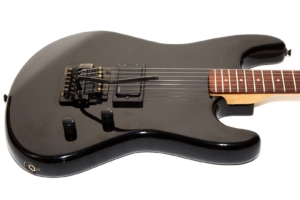
As you might have guessed by looking at the picture, this is a very simple instrument so let’s see if it can hold up against the impossibly high standards that I have for Guild electric guitars.
Introduction
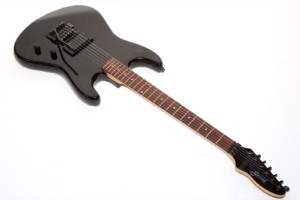
As a guitarist who learned in the ’70s and played in the ’80s, I played a fair bit of straight up rock along with a healthy dose of hair metal, and I can tell you that my guitar was usually set to the bridge pickup. I just liked that biting distortion that I got when using the bridge pickup in a high gain amp so, if I never used the neck pickup, why have it at all? That’s the theory behind the single-pickup super Strat.
There are those that will also argue that the neck pickup in a multi-pickup guitar pulls down on the strings and causes the strings to behave differently. This is not just crazy guitarist psuedo-science as this very issue can be found on Strats when the pickups are too close to the strings. Dissonant overtones are the result of this scenario and the behavior is colloquially called Strat-itis. Strat single coil pickups aren’t built like humbuckers, though, as the magnets in Strat single coil pickups are the pole piece themselves while humbucker magnets are bars that sit underneath the pole pieces. This means that the Strat pickup magnets are directly affecting the strings while the humbucker magnets are indirectly (through the pole pieces) affecting the strings. Honestly, though, having been around in the ’80s I think the reason most players went for the single pickup guitar was probably because it looked bad-ass.
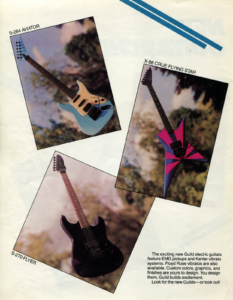
Another thing I love about this particular catalog is that if you look closely at some of the photos of the guitars you can see the strings that were used to hang them. These guitars all appear to have been hung from trees in the park somewhere by fishing line and if you zoom into the catalog page and then zoom in some more then look on the bottom of each pic you’ll see the monofilament tied to the bottom strap peg reflecting in the sunlight. Hey – Photoshop didn’t even exist until 1988 so they did the best with what they could and even today I think that’s a pretty cool looking catalog. It’s also damn rare! If you’ve got one of these I’d love to buy it from you!
At some point in the mid-80s the S270 was renamed the Spirit. According to this article in Vintage Guitar magazine Guild filed for chapter 11 bankruptcy in 1988 and ceased solid-body guitar manufacturing which explains why I don’t recall ever seeing one of the Spirit-labeled S270s. For all I know they look just the same as the Flyer since the one I have doesn’t say Flyer on it anywhere.
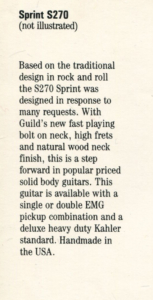
I own or have owned most of the Guild super-Strat and other shredtastic guitars from the ’80s, and this is probably one of the simplest given its single pickup, lack of controls, and bolt-on neck. I also got this guitar for a song because these Guild electrics seem to fly under the radar which is a shame because as you’re about to read, this is really one hell of a guitar. What makes it so great? Well, you’re just going to have to keep reading because I get paid by the word. Actually, come to think of it, I don’t get paid at all. Now I’m sad.
If there’s one thing that cures sadness for me it’s strapping on a pointy ’80s guitar and turning the amp up to seismic levels and having done just that I’m ready for the rest of the review.
Finish
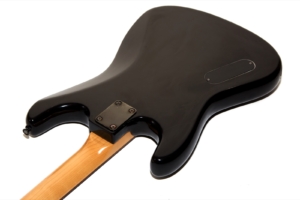
This guitar is quite obviously black. There’s really not much else to say. Well, the neck isn’t black so let’s talk about that next.
Fretboard and Neck
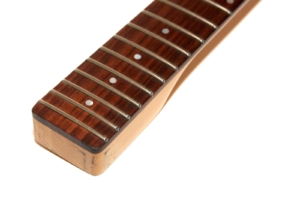
The neck appears to be rift-sawn maple and the fretboard is a beautiful slab of unbound rosewood that is so pretty with an application of bore oil that I am still blown away by how great it looks considering that this was the least-expensive electric that Guild sold at the time.
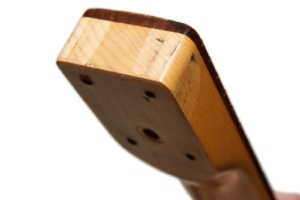
The neck is attached to the body with four wood screws that are threaded right into the neck. Some modern necks use bolts and inserts instead of wood screws and there’s a good article on that here. If I were of the constantly taking the neck off of my guitar persuasion I’d definitely prefer that, but since I see no reason to remove the neck ever again, I’m certainly fine with the wood screws.
The frets are among the largest I’ve ever measured on a Guild measuring 0.05″ high by 0.11″ wide making them 6150 jumbo frets. The fretboard radius measured 10″ on my gauges, though I could be convinced that it’s 9.5″ since there’s a subtle difference between those two and I’d imagine that 9.5″ would be more commonly used.
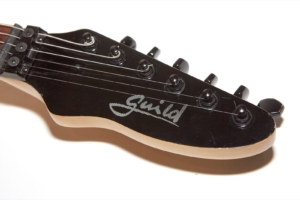
Build Quality
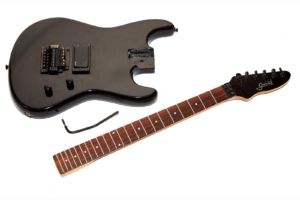
That said, the guitar feels amazing when you pick it up, and it just exudes that Westerly build quality that Guilds of the time are known for. This being the lowest-priced Guild electric of the time, there is no binding, no block inlays, and nothing at all fancy about the guitar, though the rosewood fretboard is beautiful as previously stated.
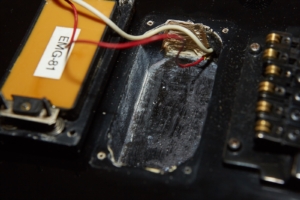
This guitar has the typical Guild quality feel to it and sustains well given the Kahler which will never be as resonant as a good old-fashioned stop tail or string-through design.
Pickup
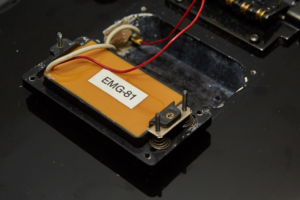
Since there is only one pickup there is no selection switch. Since there are no options installed (A fat control was a $100 upgrade at the time) the knobs are not push-pull and there are no toggles. You plug this guitar in, turn up the volume, and rock. End of story.
Electronics
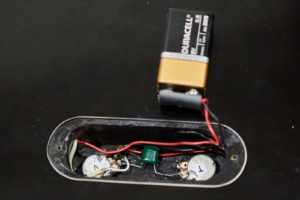
The potentiometers are small and since there’s not much to the circuit, the control cavity it small, too. The battery is contained within that small control cavity which is accessed via to pick guard screws. There potentiometers being small is a sign that these are not the original pots and sure enough the originals are in the case in a nice box. I’m not sure why they were replaced because the originals appear to be fine and no new functionality was added by replacing them. Perhaps one was sporadic or someone changed the pickup to something else then changed it back.
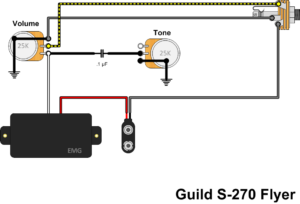
There is the added complexity of the 9V battery, but it is typical of EMG designs in that the output jack is stereo so that the battery is only in use if the guitar cord is plugged into the guitar.
Hardware
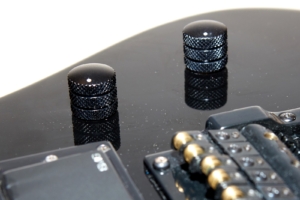
The Kahler is a 2300 Pro and works great. My only complaint with 2300 Pros is that the fine tuning knobs can get thrown out of whack by normal play if you’re a fan of palm muting, but aside from that I like them just fine with the exception of the arm threads which I’ll cover next.
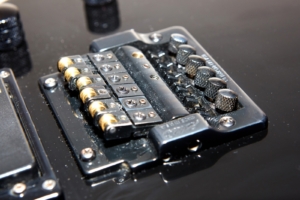
Sound
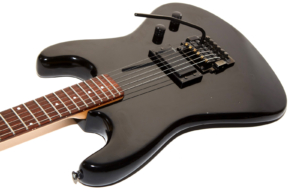
I was kind of thrown by the single pickup configuration because normally for these recordings I have to get a certain rhythm down for changing controls between pickup changes or feature changes and there was none of that with this guitar. For a guy who lives in a pretty complex world and as someone who owns some pretty complex guitars, I couldn’t decide if the simplicity of this guitar was refreshing or jarring.
ODS100
Open Chords #1
7th Chords
JCM-800
A Barre
D-Shape
Riff
Citrus
D-Shape
Since there is only one pickup and thus no pickup selector switch, the recordings are each of the one pickup with the knobs on 10.
I was surprised by the chime I could pull from this guitar and I attribute that mostly to the longer scale. I was also surprised at what appeared to be a bit lower output than what I’m used to with active pickups. It’s hard to judge this guitar on that because the electronics are not original, but the simple math derived from the values on the pots and capacitor being the same means that shouldn’t make a difference. And yes, I put in a fresh battery.
Though not present on the recordings, I found myself bumping the gain a bit on the amp while playing at high gain because I wasn’t getting that high saturation I normally expect from an active pickup, though I wouldn’t count this as a bad thing because I generally favor low-wind passive pickups anyway and I can always add more drive. Given the choice I’ll pick less signal from the guitar over too much signal every time.
Playability
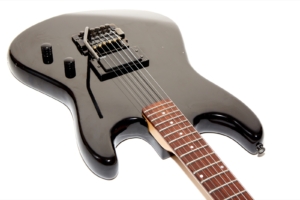
The guitar feels great both seated and standing and is balanced quite well which I attribute to the genius that is the Fender Stratocaster body shape. The relatively curvy fretboard radius makes chording a dream and because the Kahler is well set up, playing leads does not lead to fretting they way a poorly set up 9.5″ radius fretboard can.
A guitar is a tool and at a minimum should not get in the players way. This is why I don’t usually recommend cheap guitars for beginners because a poorly made or badly sat up guitar can get in the new player’s way thus making it less likely that they’ll want to play, let alone practice. There’s a minimum that I expect from a guitar, and this guitar goes way beyond that. Why does this guitar exceed that minimum? Because it’s a Westerly-made Guild.
The quality and great setup on this guitar, coupled with it’s great tone and articulate distortion make this guitar an absolute blast to play for this aging metal-head hair-band lover.
Conclusion
I don’t see these come up for sale too often, so when I saw this one in mint condition i was thrilled to have one to review. Then I started to play it and fell in love with it because it’s just a blast to play. With no controls aside from tone and volume, there’s nothing to worry about except your own chops and I think that’s why the simplicity felt jarring. Get rid of the distractions and focus on the art and there are suddenly no excuses. That what a guitar like this is for.
Yes, this is a simple guitar, and yes, it was the least-expensive electric that Guild sold for a time, but don’t think for a minute that the S270 Flyer can’t deliver because it can, and it delivers the goods with graceful aplomb the way that most Westerly Guilds do.
As previously stated, this is a very simple guitar. It is, however, a very simple guitar that is extraordinarily well made and then assembled with quality parts in the Westerly Guild factory. That matters a lot and any seasoned guitarist would pick up this guitar and nod in satisfaction while they started playing their best ’80s riffs.
I have a Guild S281 Flyer which is arguably a “better” model with its double humbuckers and slightly different body design but the simple truth is that I like this S270 better.
Highly recommended.
Donate: PayPal Crypto:
ETH: 0x0AC57f8e0A49dc06Ed4f7926d169342ec4FCd461
Doge: DFWpLqMr6QF67t4wRzvTtNd8UDwjGTQBGs




Do you have any information on the S-282? I picked one up several years ago and cannot find any info on it, I even email Guild and the only thing they can tell me is it was made in 1984.
Can you send me pics?
I just joined a fb group and those guys told me everything I didn’t know about mine…
“Guild Guitar owners and fans”
Anyone who knows anything legitimate on that FB group is either a member of, or learned it from LetsTalkGuild.com. 🙂
I now own an S282. Hopefully a review will be coming on it.